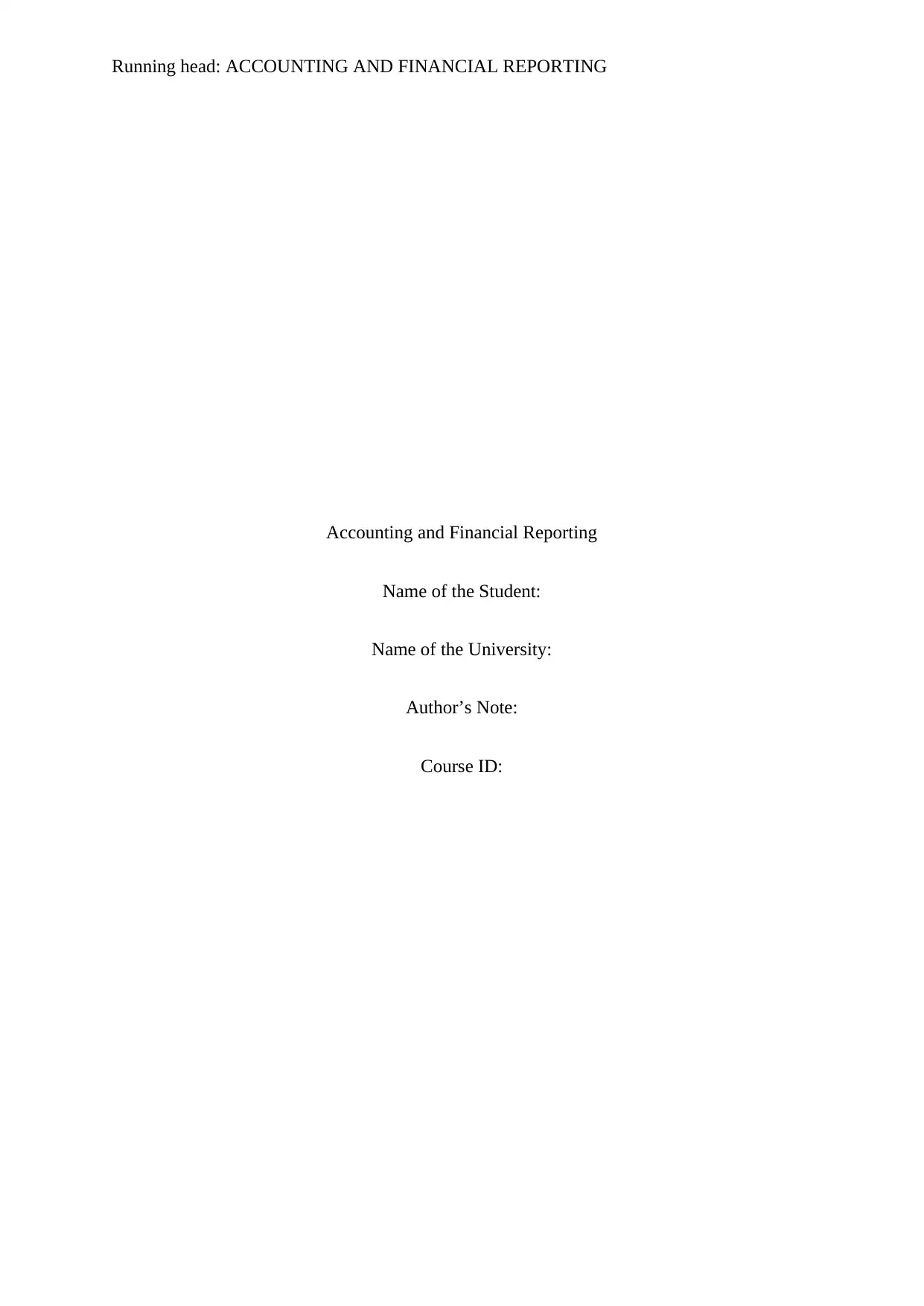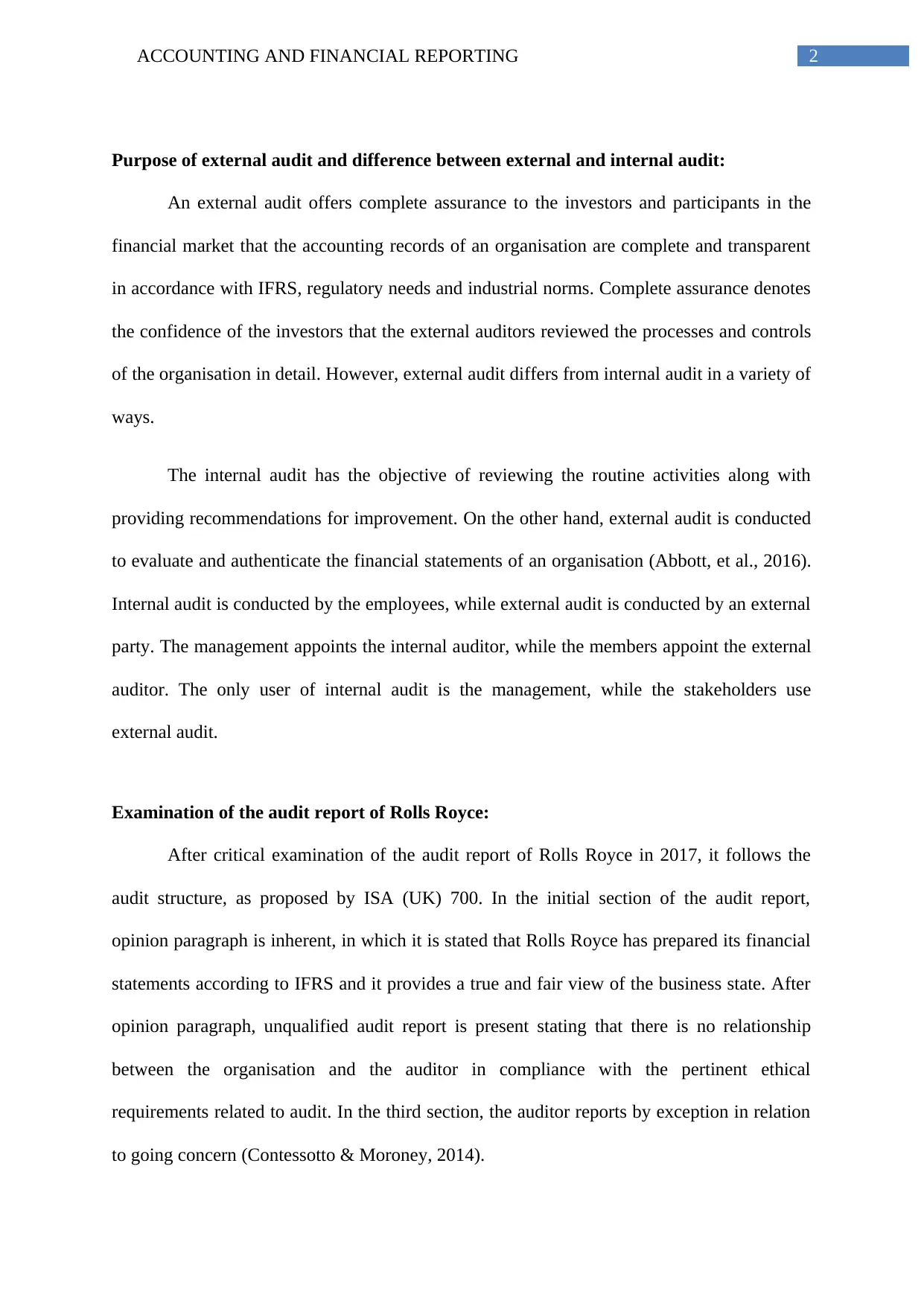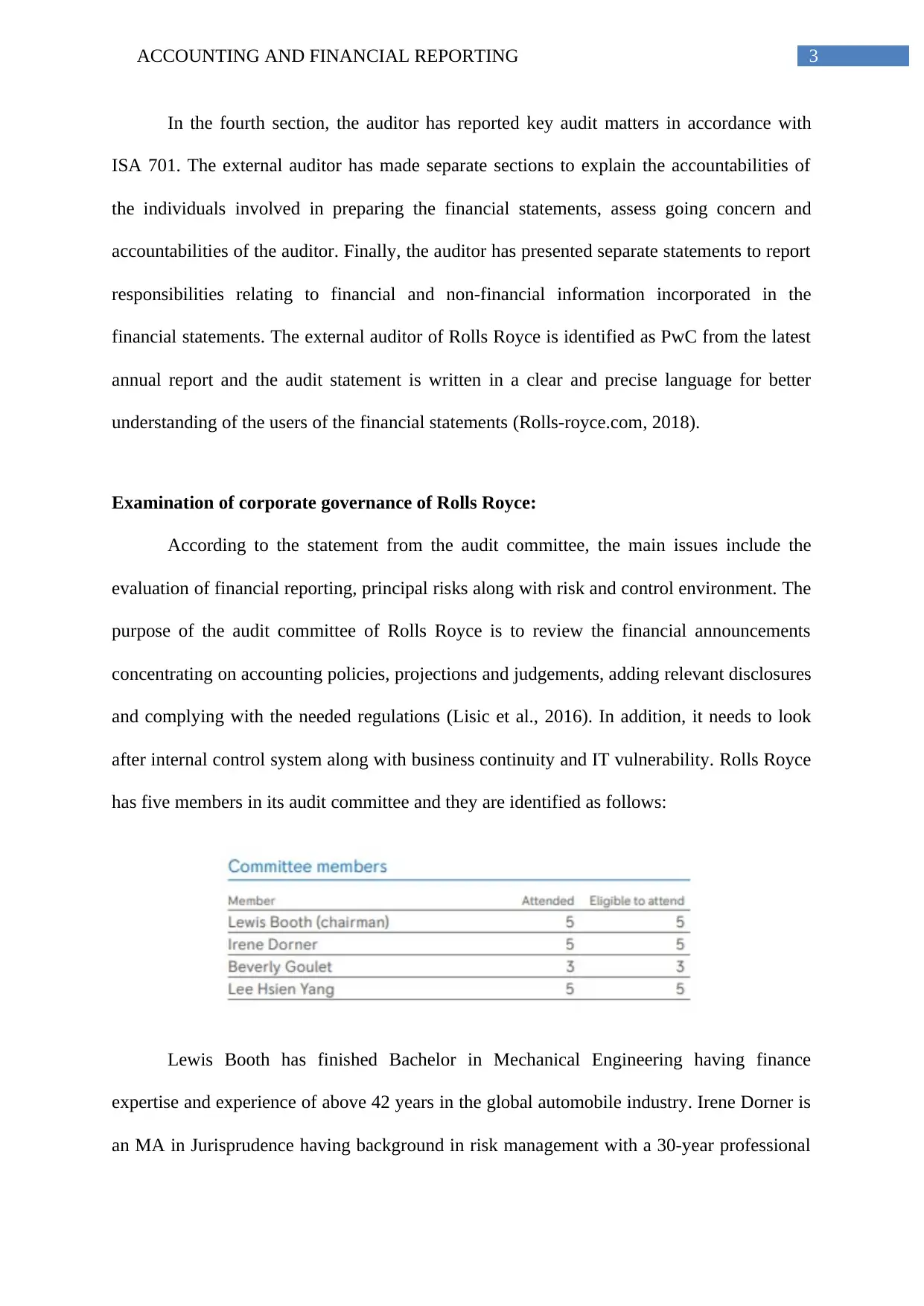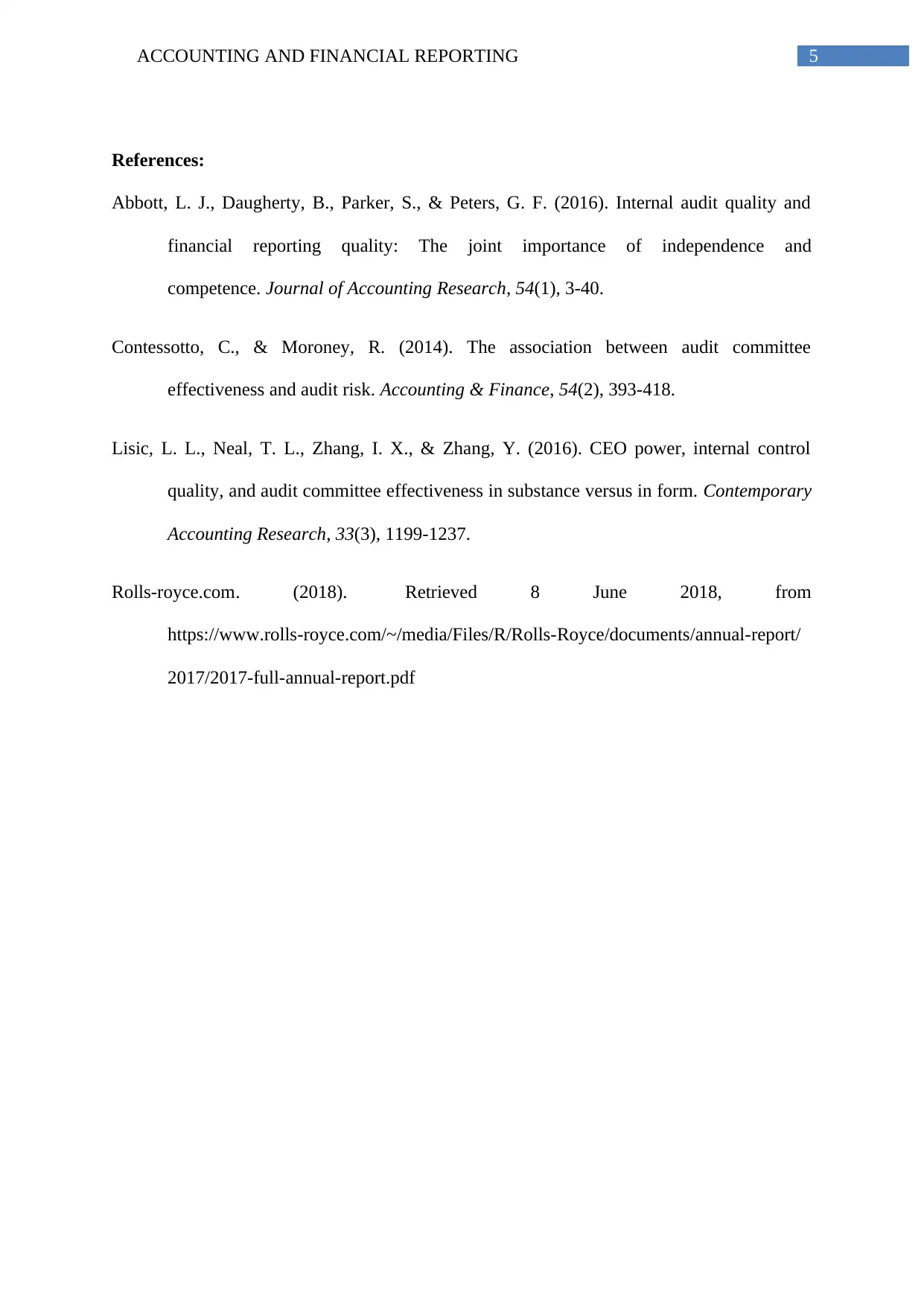Rolls Royce Audit Report: Examining Financial Reporting and Governance
VerifiedAdded on 2023/06/11
|6
|882
|300
Report
AI Summary
This report provides an analysis of Rolls Royce's accounting and financial reporting practices, focusing on the external audit and corporate governance. It differentiates between external and internal audits, emphasizing the assurance provided by external audits regarding the completeness and transparency of financial records in accordance with IFRS and regulatory standards. The report examines Rolls Royce's 2017 audit report, noting its compliance with ISA (UK) 700, including the opinion paragraph, unqualified audit report, and key audit matters. Furthermore, it assesses Rolls Royce's corporate governance, highlighting the audit committee's role in evaluating financial reporting, principal risks, and internal controls. The report also identifies the members of the audit committee and their relevant expertise. The analysis concludes by referencing key sources that support the findings and provide further context to the discussion.

Running head: ACCOUNTING AND FINANCIAL REPORTING
Accounting and Financial Reporting
Name of the Student:
Name of the University:
Author’s Note:
Course ID:
Accounting and Financial Reporting
Name of the Student:
Name of the University:
Author’s Note:
Course ID:
Paraphrase This Document
Need a fresh take? Get an instant paraphrase of this document with our AI Paraphraser

1ACCOUNTING AND FINANCIAL REPORTING
Table of Contents
Purpose of external audit and difference between external and internal audit:.........................2
Examination of the audit report of Rolls Royce:.......................................................................2
Examination of corporate governance of Rolls Royce:.............................................................3
References:.................................................................................................................................5
Table of Contents
Purpose of external audit and difference between external and internal audit:.........................2
Examination of the audit report of Rolls Royce:.......................................................................2
Examination of corporate governance of Rolls Royce:.............................................................3
References:.................................................................................................................................5

2ACCOUNTING AND FINANCIAL REPORTING
Purpose of external audit and difference between external and internal audit:
An external audit offers complete assurance to the investors and participants in the
financial market that the accounting records of an organisation are complete and transparent
in accordance with IFRS, regulatory needs and industrial norms. Complete assurance denotes
the confidence of the investors that the external auditors reviewed the processes and controls
of the organisation in detail. However, external audit differs from internal audit in a variety of
ways.
The internal audit has the objective of reviewing the routine activities along with
providing recommendations for improvement. On the other hand, external audit is conducted
to evaluate and authenticate the financial statements of an organisation (Abbott, et al., 2016).
Internal audit is conducted by the employees, while external audit is conducted by an external
party. The management appoints the internal auditor, while the members appoint the external
auditor. The only user of internal audit is the management, while the stakeholders use
external audit.
Examination of the audit report of Rolls Royce:
After critical examination of the audit report of Rolls Royce in 2017, it follows the
audit structure, as proposed by ISA (UK) 700. In the initial section of the audit report,
opinion paragraph is inherent, in which it is stated that Rolls Royce has prepared its financial
statements according to IFRS and it provides a true and fair view of the business state. After
opinion paragraph, unqualified audit report is present stating that there is no relationship
between the organisation and the auditor in compliance with the pertinent ethical
requirements related to audit. In the third section, the auditor reports by exception in relation
to going concern (Contessotto & Moroney, 2014).
Purpose of external audit and difference between external and internal audit:
An external audit offers complete assurance to the investors and participants in the
financial market that the accounting records of an organisation are complete and transparent
in accordance with IFRS, regulatory needs and industrial norms. Complete assurance denotes
the confidence of the investors that the external auditors reviewed the processes and controls
of the organisation in detail. However, external audit differs from internal audit in a variety of
ways.
The internal audit has the objective of reviewing the routine activities along with
providing recommendations for improvement. On the other hand, external audit is conducted
to evaluate and authenticate the financial statements of an organisation (Abbott, et al., 2016).
Internal audit is conducted by the employees, while external audit is conducted by an external
party. The management appoints the internal auditor, while the members appoint the external
auditor. The only user of internal audit is the management, while the stakeholders use
external audit.
Examination of the audit report of Rolls Royce:
After critical examination of the audit report of Rolls Royce in 2017, it follows the
audit structure, as proposed by ISA (UK) 700. In the initial section of the audit report,
opinion paragraph is inherent, in which it is stated that Rolls Royce has prepared its financial
statements according to IFRS and it provides a true and fair view of the business state. After
opinion paragraph, unqualified audit report is present stating that there is no relationship
between the organisation and the auditor in compliance with the pertinent ethical
requirements related to audit. In the third section, the auditor reports by exception in relation
to going concern (Contessotto & Moroney, 2014).
⊘ This is a preview!⊘
Do you want full access?
Subscribe today to unlock all pages.

Trusted by 1+ million students worldwide

3ACCOUNTING AND FINANCIAL REPORTING
In the fourth section, the auditor has reported key audit matters in accordance with
ISA 701. The external auditor has made separate sections to explain the accountabilities of
the individuals involved in preparing the financial statements, assess going concern and
accountabilities of the auditor. Finally, the auditor has presented separate statements to report
responsibilities relating to financial and non-financial information incorporated in the
financial statements. The external auditor of Rolls Royce is identified as PwC from the latest
annual report and the audit statement is written in a clear and precise language for better
understanding of the users of the financial statements (Rolls-royce.com, 2018).
Examination of corporate governance of Rolls Royce:
According to the statement from the audit committee, the main issues include the
evaluation of financial reporting, principal risks along with risk and control environment. The
purpose of the audit committee of Rolls Royce is to review the financial announcements
concentrating on accounting policies, projections and judgements, adding relevant disclosures
and complying with the needed regulations (Lisic et al., 2016). In addition, it needs to look
after internal control system along with business continuity and IT vulnerability. Rolls Royce
has five members in its audit committee and they are identified as follows:
Lewis Booth has finished Bachelor in Mechanical Engineering having finance
expertise and experience of above 42 years in the global automobile industry. Irene Dorner is
an MA in Jurisprudence having background in risk management with a 30-year professional
In the fourth section, the auditor has reported key audit matters in accordance with
ISA 701. The external auditor has made separate sections to explain the accountabilities of
the individuals involved in preparing the financial statements, assess going concern and
accountabilities of the auditor. Finally, the auditor has presented separate statements to report
responsibilities relating to financial and non-financial information incorporated in the
financial statements. The external auditor of Rolls Royce is identified as PwC from the latest
annual report and the audit statement is written in a clear and precise language for better
understanding of the users of the financial statements (Rolls-royce.com, 2018).
Examination of corporate governance of Rolls Royce:
According to the statement from the audit committee, the main issues include the
evaluation of financial reporting, principal risks along with risk and control environment. The
purpose of the audit committee of Rolls Royce is to review the financial announcements
concentrating on accounting policies, projections and judgements, adding relevant disclosures
and complying with the needed regulations (Lisic et al., 2016). In addition, it needs to look
after internal control system along with business continuity and IT vulnerability. Rolls Royce
has five members in its audit committee and they are identified as follows:
Lewis Booth has finished Bachelor in Mechanical Engineering having finance
expertise and experience of above 42 years in the global automobile industry. Irene Dorner is
an MA in Jurisprudence having background in risk management with a 30-year professional
Paraphrase This Document
Need a fresh take? Get an instant paraphrase of this document with our AI Paraphraser

4ACCOUNTING AND FINANCIAL REPORTING
career in HSBC. Beverly Goulet is a Bachelor of Corporate and Securities Law and she has
been an important executive member of the American Airlines from 1993 to 2017. Lee Hsien
Yang is a Bachelor of Engineering having worked as executive for 12 years in Singapore
Telecommunications Limited.
career in HSBC. Beverly Goulet is a Bachelor of Corporate and Securities Law and she has
been an important executive member of the American Airlines from 1993 to 2017. Lee Hsien
Yang is a Bachelor of Engineering having worked as executive for 12 years in Singapore
Telecommunications Limited.

5ACCOUNTING AND FINANCIAL REPORTING
References:
Abbott, L. J., Daugherty, B., Parker, S., & Peters, G. F. (2016). Internal audit quality and
financial reporting quality: The joint importance of independence and
competence. Journal of Accounting Research, 54(1), 3-40.
Contessotto, C., & Moroney, R. (2014). The association between audit committee
effectiveness and audit risk. Accounting & Finance, 54(2), 393-418.
Lisic, L. L., Neal, T. L., Zhang, I. X., & Zhang, Y. (2016). CEO power, internal control
quality, and audit committee effectiveness in substance versus in form. Contemporary
Accounting Research, 33(3), 1199-1237.
Rolls-royce.com. (2018). Retrieved 8 June 2018, from
https://www.rolls-royce.com/~/media/Files/R/Rolls-Royce/documents/annual-report/
2017/2017-full-annual-report.pdf
References:
Abbott, L. J., Daugherty, B., Parker, S., & Peters, G. F. (2016). Internal audit quality and
financial reporting quality: The joint importance of independence and
competence. Journal of Accounting Research, 54(1), 3-40.
Contessotto, C., & Moroney, R. (2014). The association between audit committee
effectiveness and audit risk. Accounting & Finance, 54(2), 393-418.
Lisic, L. L., Neal, T. L., Zhang, I. X., & Zhang, Y. (2016). CEO power, internal control
quality, and audit committee effectiveness in substance versus in form. Contemporary
Accounting Research, 33(3), 1199-1237.
Rolls-royce.com. (2018). Retrieved 8 June 2018, from
https://www.rolls-royce.com/~/media/Files/R/Rolls-Royce/documents/annual-report/
2017/2017-full-annual-report.pdf
⊘ This is a preview!⊘
Do you want full access?
Subscribe today to unlock all pages.

Trusted by 1+ million students worldwide
1 out of 6
Related Documents
Your All-in-One AI-Powered Toolkit for Academic Success.
+13062052269
info@desklib.com
Available 24*7 on WhatsApp / Email
![[object Object]](/_next/static/media/star-bottom.7253800d.svg)
Unlock your academic potential
Copyright © 2020–2025 A2Z Services. All Rights Reserved. Developed and managed by ZUCOL.





